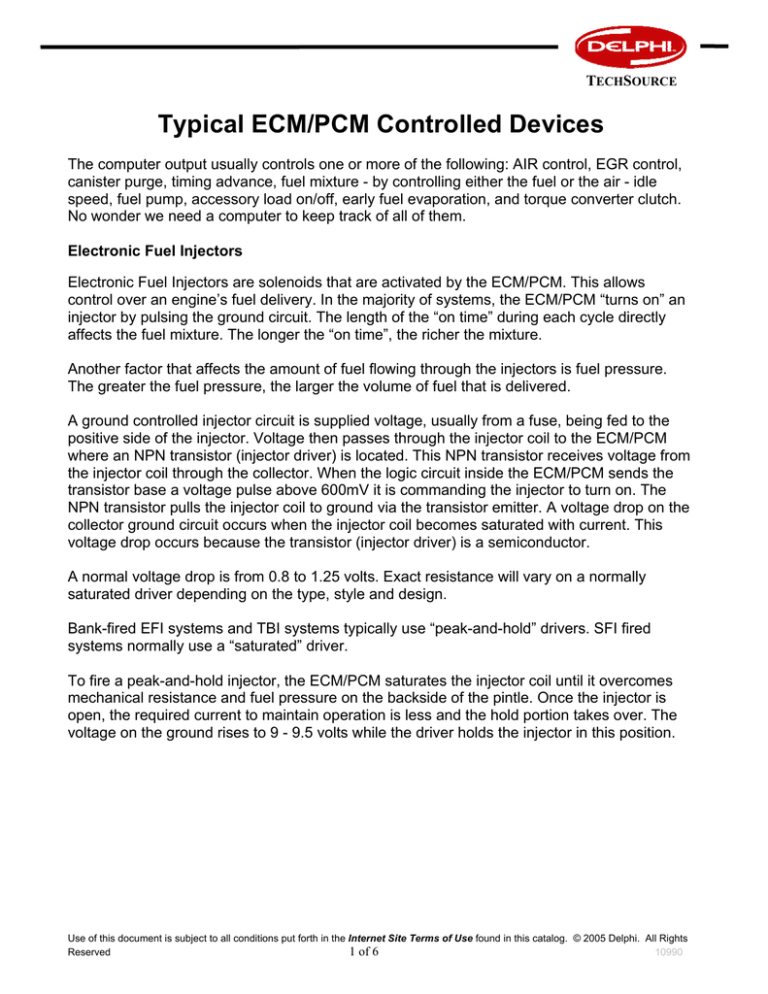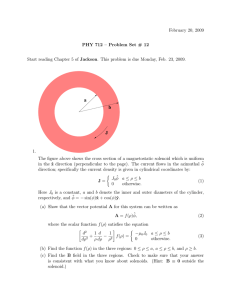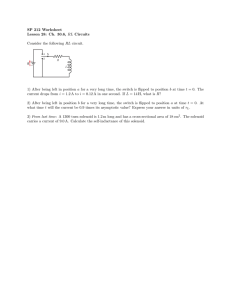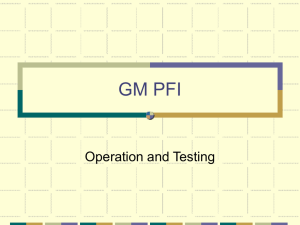
TECHSOURCE
Typical ECM/PCM Controlled Devices
The computer output usually controls one or more of the following: AIR control, EGR control,
canister purge, timing advance, fuel mixture - by controlling either the fuel or the air - idle
speed, fuel pump, accessory load on/off, early fuel evaporation, and torque converter clutch.
No wonder we need a computer to keep track of all of them.
Electronic Fuel Injectors
Electronic Fuel Injectors are solenoids that are activated by the ECM/PCM. This allows
control over an engine’s fuel delivery. In the majority of systems, the ECM/PCM “turns on” an
injector by pulsing the ground circuit. The length of the “on time” during each cycle directly
affects the fuel mixture. The longer the “on time”, the richer the mixture.
Another factor that affects the amount of fuel flowing through the injectors is fuel pressure.
The greater the fuel pressure, the larger the volume of fuel that is delivered.
A ground controlled injector circuit is supplied voltage, usually from a fuse, being fed to the
positive side of the injector. Voltage then passes through the injector coil to the ECM/PCM
where an NPN transistor (injector driver) is located. This NPN transistor receives voltage from
the injector coil through the collector. When the logic circuit inside the ECM/PCM sends the
transistor base a voltage pulse above 600mV it is commanding the injector to turn on. The
NPN transistor pulls the injector coil to ground via the transistor emitter. A voltage drop on the
collector ground circuit occurs when the injector coil becomes saturated with current. This
voltage drop occurs because the transistor (injector driver) is a semiconductor.
A normal voltage drop is from 0.8 to 1.25 volts. Exact resistance will vary on a normally
saturated driver depending on the type, style and design.
Bank-fired EFI systems and TBI systems typically use “peak-and-hold” drivers. SFI fired
systems normally use a “saturated” driver.
To fire a peak-and-hold injector, the ECM/PCM saturates the injector coil until it overcomes
mechanical resistance and fuel pressure on the backside of the pintle. Once the injector is
open, the required current to maintain operation is less and the hold portion takes over. The
voltage on the ground rises to 9 - 9.5 volts while the driver holds the injector in this position.
Use of this document is subject to all conditions put forth in the Internet Site Terms of Use found in this catalog. © 2005 Delphi. All Rights
Reserved
1 of 6
10990
TECHSOURCE
Typical ECM/PCM Controlled Devices (continued)
Electronic Fuel Injectors (continued)
Once the peak and hold injector is open,
manufacturers will vary the method for the hold
portion, a pulsed ground or resistor on ground.
Simply put, the hold portion creates an elevated
ground similar to that of a dim headlight with a
bad ground.
Saturated switch drivers are used with
injectors that have relatively high resistances
(i.e.16 ohms). Only the resistance of the
circuit itself limits current flow in the circuit.
Saturated switch driver circuits require a
longer time to build the magnetic field
necessary to open the injector. When deenergized, the magnetic field collapses and a
spring inside of the injector causes the pintle
to close, shutting off the flow of gasoline
through the injector. The injector circuit is
designed to dissipate the voltages induced by
the magnetic field build up within the injector
coils as they are energized and de-energized.
Use of this document is subject to all conditions put forth in the Internet Site Terms of Use found in this catalog. © 2005 Delphi. All Rights
Reserved
2 of 6
10990
TECHSOURCE
Typical ECM/PCM Controlled Devices (continued)
Idle Air Control
Port-fuel injected (and some throttle body)
engines use an air bypass solenoid valve to
regulate the amount of air permitted to flow
around the closed throttle plate. The ECM/PCM
operates this device using a pulse-width
modulated ground signal and variable ground
voltage. As engine idle load increases (e.g. A/C
on), the ECM/PCM commands a higher duty
cycle and lower ground voltage, which allows
additional air to bypass the throttle plate. To
compensate for the additional airflow, the
computer increases injector pulse-width based
on the MAP/MAF signals and oxygen sensor
voltage.
As you turn on accessories like the air-conditioning or rear-defogger, the scan tool value
should increase with a corresponding increase in engine speed. This rise in engine speed is
only momentary until the engine stabilizes at the pre-programmed idle RPM.
Evaporative Emissions Solenoid
The Evaporative Emission Control System prevents fuel tank vapors from escaping into the
atmosphere. As fuel evaporates in the tank, the vapors are routed to a charcoal canister. The
vapors are stored in the canister until the ECM/PCM determines the correct time for purging.
Purging allows intake manifold vacuum to draw the fuel vapors into the engine where they are
burned. Fuel vapor flow is controlled by use of an electronically controlled solenoid.
On some vehicles the duty cycle of the solenoid is either 0% (OFF) or 100% (ON) depending
on engine operating conditions. When the ECM/PCM completes the solenoid circuit to
ground, the energized solenoid either blocks vacuum to the canister or controls it, depending
upon the manufacturer.
Use of this document is subject to all conditions put forth in the Internet Site Terms of Use found in this catalog. © 2005 Delphi. All Rights
Reserved
3 of 6
10990
TECHSOURCE
Typical ECM/PCM Controlled Devices (continued)
Evaporative Emissions Solenoid
When the ECM/PCM opens the solenoid,
vacuum is permitted to reach the canister
and the vapors are purged.
Some systems will control the purge flow
by the use of a fixed frequency that is duty
cycled to a pulse-width-modulated
solenoid. So rather than displaying an
on/off signal, the scan tool will display duty
cycle percentage.
Exhaust Gas Recirculation (EGR) Vacuum Solenoid
The EGR system reduces oxides of nitrogen (NOx)
emissions by diluting the air/fuel charge with a
metered amount of recycled inert exhaust gas. Since
this recycled gas is non-reactive, it serves to lower
peak flame temperatures during the combustion
process. This results in lower combustion pressure
and minimal spark knock.
Typical EGR operation is controlled by use of an
electronically controlled solenoid. This solenoid
controls vacuum to the EGR valve.
On some vehicles the duty cycle of the solenoid is
either 0% (OFF) or 100% (ON) depending on engine
operating conditions. When the ECM/PCM completes
the solenoid circuit to ground, the energized solenoid
either blocks vacuum to the EGR Valve or controls it,
depending upon the manufacturer.
When the ECM/PCM opens the solenoid, vacuum is permitted to reach the EGR and the
valve opens.
Use of this document is subject to all conditions put forth in the Internet Site Terms of Use found in this catalog. © 2005 Delphi. All Rights
Reserved
4 of 6
10990
TECHSOURCE
Typical ECM/PCM Controlled Devices (continued)
Exhaust Gas Recirculation (EGR) Vacuum Solenoid (continued)
Some systems will control the vacuum to the EGR by the use of a fixed frequency that is duty
cycled to a pulse-width-modulated solenoid. So rather than displaying an on/off signal, the
scan tool will display percentage of duty cycle.
Note: Some systems use a solenoid to vent vacuum from the EGR valve.
Electronically Controlled EGR Valves
Digital
A digital EGR valve is an electrically operated valve that
supplies exhaust gas recirculation back to the engine,
independent of intake manifold vacuum.
Instead of having a vacuum diaphragm and vacuum
source, the digital valve has three internal solenoids,
each attached to a different diameter pintle. All the
solenoids receive a common voltage supply. Inputs
from the throttle position, coolant and map sensors are
supplied to the computer. Once the computer receives
the proper inputs, it supplies a ground to energize the
solenoid, or combination of solenoids, to provide the
required orifice size.
A digital valve receives commands from the ECM/PCM
to activate the EGR valve. The valve controls EGR flow
to the intake manifold through three orifices that
increase in size to produce seven combinations. When
each solenoid is energized, the armature lifts the pintle
off its seat to permit exhaust flow.
Accuracy of the flow rate is determined by total orifice
size, which is dependent upon the combination of
solenoids energized. The result is an extremely
accurate control of the exhaust gases' flow rate back
into the engine.
Use of this document is subject to all conditions put forth in the Internet Site Terms of Use found in this catalog. © 2005 Delphi. All Rights
Reserved
5 of 6
10990
TECHSOURCE
Typical ECM/PCM Controlled Devices (continued)
Linear
Another electronic EGR valve is the linear valve.
This valve also controls EGR flow into the intake
manifold with a solenoid. Computer outputs
dictate the amount that the solenoid should open
the pintle.
Linear valves have a single control solenoid
attached to the pintle and a position sensor inside
to tell the computer the location of the pintle. The
on-board computer accepts inputs from the
throttle position, coolant and MAP sensors to
determine when to energize the solenoid. The
computer pulses the command signal to the
solenoid for accurate regulation of EGR flow.
Ignition System
The ECM/PCM uses the input signals to calculate when the ignition system needs to fire the
spark plugs by outputting a command to fire the ignition coil(s). The output may control the
coil directly or through an ignition module.
Charging System
The EMS controls charging system output by using a voltage sense input. The ECM/PCM
pulses generator field current.
Use of this document is subject to all conditions put forth in the Internet Site Terms of Use found in this catalog. © 2005 Delphi. All Rights
Reserved
6 of 6
10990




